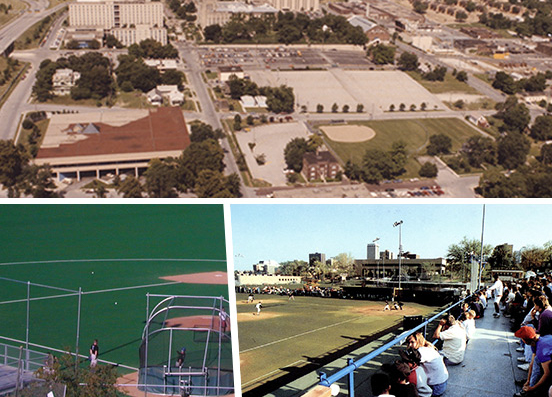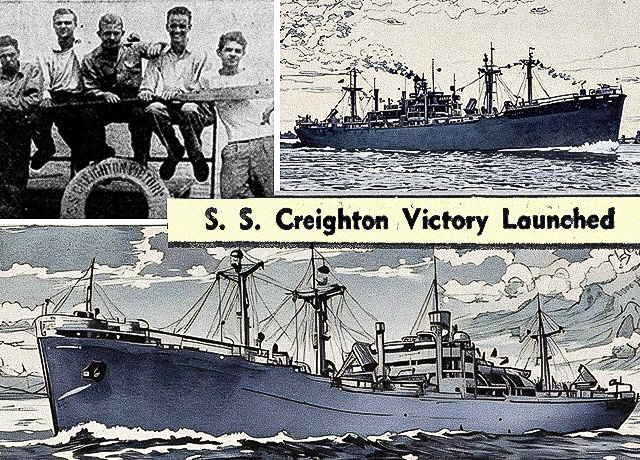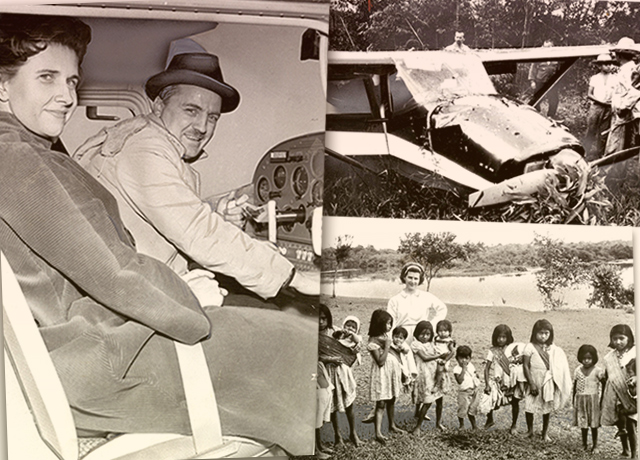Featured Testimonial About Creighton University
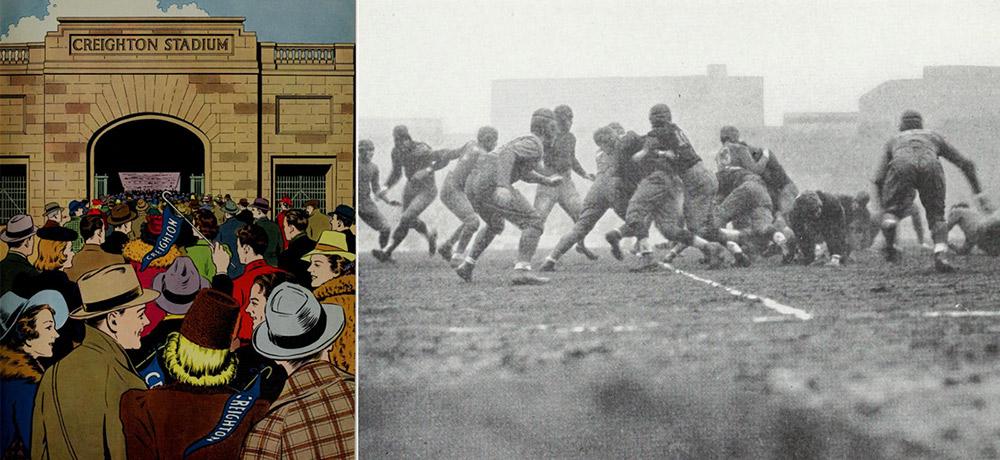
The game was simply a matter of strength and beef.
Creighton football
This is the beginning of a three-part series about the early days, abrupt end and short-lived comeback of Creighton University’s football team. The story continues with the second and third installments:
Part One — 1891: The Rise of Creighton Football
Part Two — 1942: The Fall of Creighton Football
Part Three — 1983: The “Rise” of Creighton Football
Epilogue: Images of Creighton football and its stadium
* * *
Part One — 1891: The Rise of Creighton Football
By Micah Mertes
On a dreary day in December 1891, a hastily assembled team of Creighton students played the first organized game of football in Omaha’s history. A crowd of about 500 gathered to watch a sport that few in the Midwest had seen before.
Creighton’s opponent was the Omaha Medical College (now University of Nebraska Medical Center). OMC was the clear favorite. For one, they had uniforms and equipment. Another advantage: They knew what the game of football was.
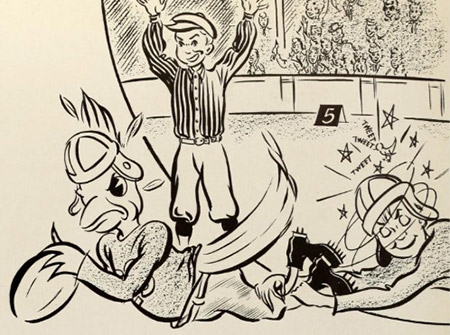
The Creighton team, meanwhile, had almost no idea what it was doing. They had no suits, no equipment, no coaches. They took the field in sweats and T-shirts. Only two of the team’s 11 players had even seen a game of football before playing in this one.
That 1891 game would consist of no forward passing, just a lot of running and plunging. As the Creightonian later wrote, the game was simply “a matter of strength and ‘beef.’”
By the end, the Creighton team’s shirts were torn to shreds and covered in mud. Most of the players had no more idea how to play football than they did at the game’s start. But Creighton won anyway.
They won 12-0, according to the Creightonian. Or 6-0, according to the Omaha World-Herald.
A tiny notice on the World-Herald sports page marked the beginning of an era.

* * *
From that day on, Creighton would gradually grow its football program, up until its abrupt end in 1942.
In the very early years, Creighton football played against local teams like Omaha High School and Lincoln Medical School. The University didn’t get an official intercollegiate team going until the early 1900s.
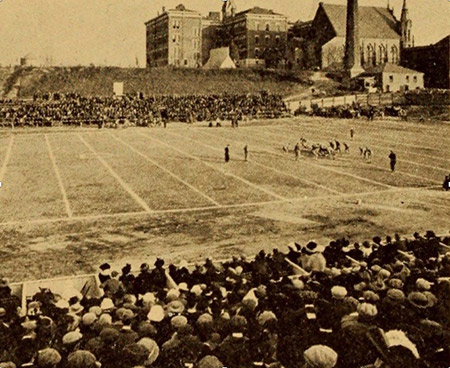
Some years, Creighton football was terrific.
They went 8-1 in 1902 and 1921, and they had several other winning seasons along the way, including a 3-0 season in 1918 cut short by World War I. Creighton football won three conference titles: two in the North Central Conference, one in the Missouri Valley Conference (sharing it with their rival Tulsa in 1936).
Yet a football program at a small private college had its limits. Take the three games the Bluejays (then “the Hilltoppers”) played against the Cornhuskers from 1904 to 1906. Nebraska routed them every time. One game’s score: 103-0.
But in the parameters of the MVC, Creighton was solid. One of the team’s biggest rivals was Drake. Year after year, the Bluejays would battle the Bulldogs for an old wooden pipe. Since the Bluejays won their final game against Drake in 1942, the pipe remained with Creighton.

Creighton had many great players along the way. Some of the most notable included:
Johnny “Slingshot” Knolla, BS’46, a halfback who led the nation in rushing with 1,420 yards in 1940. His shoes were later bronzed and put in a Creighton trophy case. Knolla is one of just four football players inducted in the Creighton Athletics Hall of Fame (see the rest here.)
Tony Porto, BS'45, DDS'46, a two-time All-American halfback for Creighton’s team in 1941 and 1942. Porto later turned down contracts with the Chicago Bears and the Detroit Lions to become a dentist, practicing for more than 60 years following two years of service in the Korean War. He was inducted in the Creighton Hall of Fame in 1990.
Ralph “Mal” Mailliard, BA'29, MA'35, a Creighton hall-of-famer who later played for the 1929 Chicago Bears and went on to become a longtime football and track coach at St. Ignatius College Prep.
Carl Vinciquerra, a Heider College of Business (then the College of Commerce) student from 1935 to 1937 who came to Creighton on a football scholarship and boxed in the 1936 Berlin Olympics. Later in life, Vinciquerra returned to Creighton to work the front desk of the Kiewit Fitness Center. Read more about Vinciquerra.
* * *
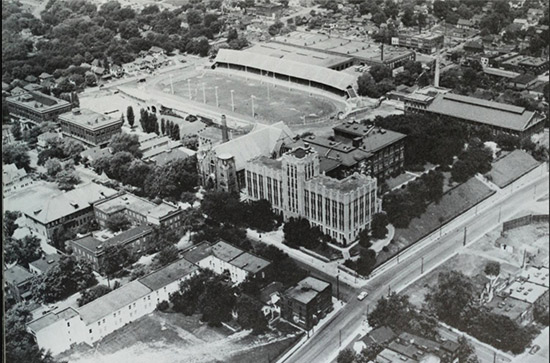
For most of its life, Creighton football didn’t have a proper home.
That changed in 1925, with the construction of Creighton Stadium. With a seating capacity of 15,000, the stadium was, at the time, the largest structure in Omaha.
The stadium stood south of Burt Street and directly west of the Old Gymnasium, where the Eppley Building, Criss Complex, parking lot and solar panels now reside.
See what campus looked like in 1949 compared to today.
Students and alumni were extremely proud of Creighton Stadium. A few years after its construction, a Creighton publication touted the venue’s state-of-the-art lighting system: “An intricate arrangement of crossbeams will throw the entire field into a state of brilliance that will surpass even daylight. Punts and passes can be followed with perfect ease.”
In the ensuing years, the stadium hosted homecoming parades and games against the likes of Notre Dame, BIG TEN schools and members of the Missouri Valley Conference. The quarter-mile cinder track surrounding the field, meanwhile, helped Creighton grow its burgeoning track program, established in 1922.

One reason so many alumni took such great pride in the stadium: They helped build it.
Creighton Stadium cost about a third of a million dollars to build in 1925. Most of the cost was covered by a loan, but to make up the difference, Creighton launched a fundraising campaign: “Buy a bag of cement for Creighton Stadium.”
More than 1,500 Creighton students set out to sell enough $1 sacks of cement to build the north and south units of the stadium. Partnering with local businesses, Creighton offered the top salespeople prizes, including typewriters, scholarships, summer vacations, even automobiles.
The campaign was a huge success, and several months later the newly completed Creighton Stadium opened for its first football game, on Nov. 21, 1925.
Exactly 17 years to the day later, Creighton would play its last football game ever.
Forty-one years after that, Creighton football would return with a team that didn’t really exist but went on to win the national championship anyway.
* * *
Read Part Two — 1942: The Fall of Creighton Football
See old photos of the team and the stadium
Sources for this series: the University Archives, the Creightonian, the Blue Jay Yearbook, the Omaha World-Herald and the Creighton Window.
* * *
The football program may no longer exist, but we still have 14 varsity teams carrying on the proud tradition of Creighton Athletics. You can keep our many programs and student-athletes successful by making a gift today!

